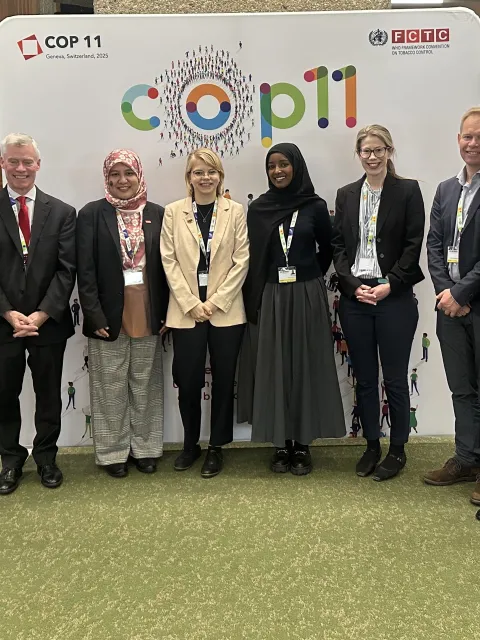Effective measures to reduce tobacco use and lung cancer incidence
WHO’s MPOWER measures are known to be effective in reducing tobacco consumption, a major risk factor for lung cancer that takes 1.8 million lives a year.

The links between smoking and lung cancer have been known for almost a century. Yet today, there are still an estimated 1.3 billion people who smoke. And while tobacco use contributes to a number of diseases, World Lung Cancer Day on 1st August is another sad reminder that it is the leading cause of lung cancer and the “single greatest avoidable risk for cancer” overall, according to the World Health Organization (WHO).
Currently, there are an estimated 2.21 million new cases of lung cancer and 1.8 million deaths attributed to lung cancer each year. The percentage of lung cancer cases attributable to tobacco use varies geographically but remains at very high levels, from 80% in the US to 60% in France and 40% in Sub-Saharan Africa. With respect to gender, there has been a worrying rise in lung cancer in women, and it is now the leading cause of cancer death in women in 28 countries, primarily in high-income regions.
“The fact that the tobacco industry still enjoys great latitude in many countries around the world in how it can produce, sell and market its products is arguably a major contributor this ongoing epidemic that costs so many lives each year. Yet the tools exist to counter this influence, raise awareness about the risks of tobacco products, support people who wish to quit smoking, prevent others from starting and reduce the incidence of smoking and the diseases that tobacco causes.”
– Yannick Romero, Knowledge & Advocacy Manager, UICC
MPOWER: Monitoring, Protection, Offer help, Warn, Enforce and Raise taxes
The MPOWER measures ratified by the WHO’s Framework Convention for Tobacco Control and introduced in 2007 were developed to assist countries in addressing the significant lack of regulatory oversight and implement interventions that have proven effective in reducing the demand for tobacco.
These measures include:
- Monitor tobacco consumption and the effectiveness of preventive measures
- Protect people from tobacco smoke
- Offering help to quit tobacco use
- Warn about the dangers of tobacco, notably through graphic labeling on packages
- Enforce bans on tobacco advertising, promotion and sponsorship
- Raise taxes on tobacco products to a level high enough to influence behaviours.
Monitoring is key for a country to understand the nature and extent of tobacco use and ensure that the most appropriate and targeted policies to reduce it are developed and implemented.
Considering the addictive nature of tobacco, support services to help people quit smoking – such as toll-free quit hotlines counselling and replacement therapies at no cost to the smoker – are also essential in reducing the incidence of tobacco use. Quitting smoking before the age of 40 lowers the risks associated with tobacco use tenfold compared to not quitting. While one person in three globally now has access to comprehensive cessation services, only 23 countries offer full coverage; cessation support therefore remains the most under-implemented measures at the country level.
Protecting individuals from second-hand smoke is also a public health imperative. Exposure to second-hand smoke at home or at work increases the risk for non-smokers of developing lung cancer by 20-30%. Designated smoke-free public areas and banning smoking indoors and at workplaces can also act as an incentive for smokers to quit and discourage never-smokers, particularly youth, from starting. A study conducted in the US showed that having a 100% smoke-free workplace reduced smoking prevalence by 6%.
Health warning labels on cigarette packages also have a demonstrated effectiveness and this measure has been the one most widely adopted in the past two years. Results of The Global Adult Tobacco Survey 2008–2010 revealed that more than half of smokers in five of the 14 countries surveyed had thought of quitting because of warning labels.
Comprehensive bans on tobacco advertising and promotion – including on social media as well as in the form of price discounts, sponsorships or promotional activities – can be very effective in countering the marketing tactics of the tobacco industry, as well as reduce consumption by an estimated 8%.
Finally, increasing taxes on tobacco products has proven to be one of the more effective means to lower smoking incidence and provides additional revenue for public health. A comparative study in France of increases in tobacco prices due to taxation and lung cancer death rates between 1950 and 2010 show a significant correlation between the two, with cancer cases rising following decreases in taxes and dropping rapidly within a decade of prices rising sharply.
Accelerating progress
Countries have moved to implement MPOWER measures at least partially. As at 2019, 36 countries had implemented at least one measure to its fullest extent and five billion people globally were covered by at least one – four times as many as in 2007 when MPOWER was introduced. Tobacco use is decreasing in most regions of the world and in 2019, for the first time, WHO projected a decrease in the number of men using tobacco.
More still needs to be done, however. Smoking incidence is still rising in Africa and parts of the Middle East and only 32 countries are currently on track to reach the target of cutting tobacco use by 30% in 2025, primarily concentrated in the Americas. At current trends and with the rise in consumption among women as well as the emergence of novel tobacco products, the tobacco epidemic is projected to cause 10 million deaths annually by 2030.
A recent study of the impact of tobacco control policies on consumption concluded that if countries globally “adopted smoking bans, health warnings and advertising bans at the strictest level and raised cigarette prices to at least 7.73 international dollars in 2009, there would have been about 100 million fewer smokers in the world in 2017.”
“By using the tried and tested tobacco control tools available through the WHO FCTC, we can help limit the influence of the tobacco industry, reduce the impact of the COVID-19 pandemic and tackle the global epidemic of NCDs.”
– Hayley Jones, Acting Director, McCabe Centre for Law & Cancer, in Proven tobacco control tools are key to a healthy recovery
To ensure that current projections of tobacco-related deaths do not materialise, this study should act as an incentive for the global health community to come together and assist all countries in overcoming the challenges that exist in implementing MPOWER measures.
UICC is actively engaging in raising awareness about tobacco industry interference, particularly in low- and middle-income countries where some 80% of tobacco use is concentrated. It has also drawn attention to the significant funding gap and called for more investments in tobacco control.
In a forthcoming article, UICC will go into more detail on how the tobacco industry influences policy and uses pseudoscience to confuse people on the relative harms of its products.
Last update
Thursday 21 April 2022
